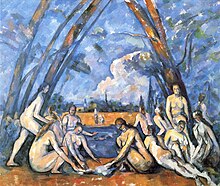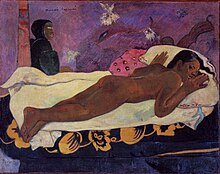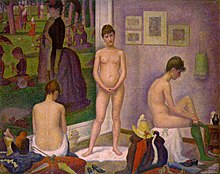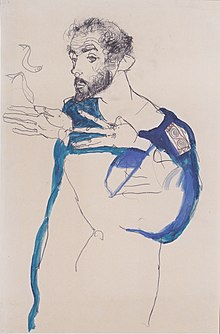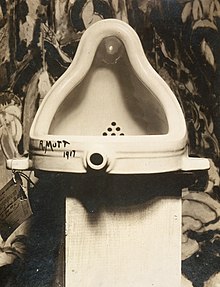Մասնակից:Angiewiki95./Ավազարկղ2
Modern art includes artistic work produced during the period extending roughly from the 1860s to the 1970s, and denotes the styles and philosophies of the art produced during that era.[1] The term is usually associated with art in which the traditions of the past have been thrown aside in a spirit of experimentation.[2] Modern artists experimented with new ways of seeing and with fresh ideas about the nature of materials and functions of art. A tendency away from the narrative, which was characteristic for the traditional arts, toward Աբստրակցիա is characteristic of much modern art. More recent artistic production is often called Ժամանակակից արվեստ or postmodern art.
Modern art begins with the heritage of painters like Վինսենթ վան Գոգ, Պոլ Սեզան, Պոլ Գոգեն, Ժորժ Սյորա and Անրի դը Տուլուզ-Լոտրեկ all of whom were essential for the development of modern art. At the beginning of the 20th century Անրի Մատիս and several other young artists including the pre-cubists Ժորժ Բրաք, Անդրե Դերեն, Raoul Dufy, Jean Metzinger and Մորիս դը Վլամինկ revolutionized the Paris art world with "wild", multi-colored, expressive landscapes and figure paintings that the critics called Ֆովիզմ. Matisse's two versions of The Dance signified a key point in his career and in the development of modern painting.[3] It reflected Matisse's incipient fascination with primitive art: the intense warm color of the figures against the cool blue-green background and the rhythmical succession of the dancing nudes convey the feelings of emotional liberation and Հեդոնիզմ.
At the start of 20th-century Western painting, and Initially influenced by Անրի դը Տուլուզ-Լոտրեկ, Պոլ Գոգեն and other late-19th-century innovators, Պաբլո Պիկասո made his first cubist paintings based on Cézanne's idea that all depiction of nature can be reduced to three solids: Խորանարդ, sphere and cone. With the painting Ավինյոնի աղջիկները (կտավ) (1907), Picasso dramatically created a new and radical picture depicting a raw and primitive brothel scene with five prostitutes, violently painted women, reminiscent of African tribal masks and his own new Կուբիզմ inventions. Կուբիզմ was jointly developed by Picasso and Ժորժ Բրաք, exemplified by Violin and Candlestick, Paris, from about 1908 through 1912. Analytic cubism, the first clear manifestation of cubism, was followed by Կուբիզմ, practiced by Braque, Picasso, Ֆերնան Լեժե, Խուան Գրիս, Albert Gleizes, Մարսել Դյուշան and several other artists into the 1920s. Կուբիզմ is characterized by the introduction of different textures, surfaces, Կոլաժ elements, papier collé and a large variety of merged subject matter.[փա՞ստ]
The notion of modern art is closely related to Մոդեռնիզմ.[4]
History
խմբագրելRoots in the 19th century
խմբագրելAlthough modern Քանդակագործություն and Ճարտարապետություն are reckoned to have emerged at the end of the 19th century, the beginnings of modern Գեղանկարչություն can be located earlier.[5] The date perhaps most commonly identified as marking the birth of modern art is 1863,[6] the year that Էդուարդ Մանե showed his painting Նախաճաշ խոտի վրա (Մանե) in the Մերժվածների սալոն in Paris. Earlier dates have also been proposed, among them 1855 (the year Գյուստավ Կուրբե exhibited The Artist's Studio) and 1784 (the year Ժակ Լուի Դավիդ completed his painting The Oath of the Horatii).[6] In the words of art historian H. Harvard Arnason: "Each of these dates has significance for the development of modern art, but none categorically marks a completely new beginning .... A gradual metamorphosis took place in the course of a hundred years."[6]
The strands of thought that eventually led to modern art can be traced back to the Enlightenment.[7] The important modern art critic Clement Greenberg, for instance, called Իմանուիլ Կանտ "the first real Modernist" but also drew a distinction: "The Enlightenment criticized from the outside ... . Modernism criticizes from the inside."[8] The Ֆրանսիական հեղափոխություն of 1789 uprooted assumptions and institutions that had for centuries been accepted with little question and accustomed the public to vigorous political and social debate. This gave rise to what art historian Ernst Gombrich called a "self-consciousness that made people select the style of their building as one selects the pattern of a wallpaper."[9]
The pioneers of modern art were Romantics, Realists and Impressionists.[10] By the late 19th century, additional movements which were to be influential in modern art had begun to emerge: Պոստիմպրեսիոնիզմ as well as Symbolism.
Influences upon these movements were varied: from exposure to Eastern decorative arts, particularly Japanese printmaking, to the coloristic innovations of Turner and Delacroix, to a search for more realism in the depiction of common life, as found in the work of painters such as Ժան Ֆրանսուա Միլլե. The advocates of realism stood against the Իդեալիզմ of the tradition-bound Ակադեմիզմ that enjoyed public and official favor.[11] The most successful painters of the day worked either through commissions or through large public exhibitions of their own work. There were official, government-sponsored painters' unions, while governments regularly held public exhibitions of new fine and decorative arts.
The Impressionists argued that people do not see objects but only the light which they reflect, and therefore painters should paint in natural light (Պլեներ) rather than in studios and should capture the effects of light in their work.[12] Impressionist artists formed a group, Société Anonyme Coopérative des Artistes Peintres, Sculpteurs, Graveurs ("Association of Painters, Sculptors, and Engravers") which, despite internal tensions, mounted a series of independent exhibitions.[13] The style was adopted by artists in different nations, in preference to a "national" style. These factors established the view that it was a "movement". These traits—establishment of a working method integral to the art, establishment of a movement or visible active core of support, and international adoption—would be repeated by artistic movements in the Modern period in art.
Early 20th century
խմբագրելAmong the movements which flowered in the first decade of the 20th century were Ֆովիզմ, Կուբիզմ, Էքսպրեսիոնիզմ, and Futurism.
During the years between 1910 and the end of World War I and after the heyday of Կուբիզմ, several movements emerged in Paris. Ջորջո դե Կիրիկո moved to Paris in July 1911, where he joined his brother Andrea (the poet and painter known as Alberto Savinio). Through his brother he met Pierre Laprade, a member of the jury at the Աշնանային սալոն where he exhibited three of his dreamlike works: Enigma of the Oracle, Enigma of an Afternoon and Self-Portrait. During 1913 he exhibited his work at the Անկախների սալոն and Salon d’Automne, and his work was noticed by Պաբլո Պիկասո, Գիյոմ Ապոլիներ, and several others. His compelling and mysterious paintings are considered instrumental to the early beginnings of Սյուրռեալիզմ. Song of Love (1914) is one of the most famous works by de Chirico and is an early example of the surrealist style, though it was painted ten years before the movement was "founded" by Անդրե Բրետոն in 1924.
World War I brought an end to this phase but indicated the beginning of a number of anti-art movements, such as Դադաիզմ, including the work of Մարսել Դյուշան, and of Սյուրռեալիզմ. Artist groups like Դե ստիլ and Բաուհաուզ developed new ideas about the interrelation of the arts, architecture, design, and art education.
Modern art was introduced to the United States with the Armory Show in 1913 and through European artists who moved to the U.S. during World War I.
After World War II
խմբագրելIt was only after World War II, however, that the U.S. became the focal point of new artistic movements.[14] The 1950s and 1960s saw the emergence of Abstract Expressionism, Color field painting, Կոնցեպտուալ արվեստists of Art & Language, Փոփ արտ, Օպտիկական արվեստ, Hard-edge painting, Minimal art, Lyrical Abstraction, Fluxus, Happening, Վիդեոարտ, Պոստմինիմալիզմ, Ֆոտոռեալիզմ and various other movements. In the late 1960s and the 1970s, Land art, Փերֆորմանս, Կոնցեպտուալ արվեստ, and other new art forms had attracted the attention of curators and critics, at the expense of more traditional media.[15] Larger installations and performances became widespread.
By the end of the 1970s, when cultural critics began speaking of "the end of painting" (the title of a provocative essay written in 1981 by Douglas Crimp), new media art had become a category in itself, with a growing number of artists experimenting with technological means such as Վիդեոարտ.[16] Painting assumed renewed importance in the 1980s and 1990s, as evidenced by the rise of Նեոէքսպրեսիոնիզմ and the revival of figurative painting.[17]
Towards the end of the 20th century, a number of artists and architects started questioning the idea of "the modern" and created typically Postmodern works.[18]
Art movements and artist groups
խմբագրել(Roughly chronological with representative artists listed.)
19th century
խմբագրել- Ռոմանտիզմ and the Ռոմանտիզմ – Ֆրանցիսկո Գոյա, Ուիլյամ Թըրներ, Էժեն Դելակրուա
- Realism – Գյուստավ Կուրբե, Ժան Բատիստ Կամիլ Կորո, Ժան Ֆրանսուա Միլլե, Ռոզա Բոնյոր
- Pre-Raphaelites – Ուիլյամ Հոլման Հանտ, Ջոն Էվերեթ Միլլե, Դանթե Գաբրիել Ռոսսետտի
- Մաքիայոլի – Ջիովաննի Ֆաթթորի, Silvestro Lega, Telemaco Signorini
- Իմպրեսիոնիզմ – Ֆրեդերիկ Բազիլ, Գյուստավ Կայբոտ, Մերի Կեսսետ, Էդգար Դեգա, Armand Guillaumin, Էդուարդ Մանե, Կլոդ Մոնե, Բերտա Մորիզո, Պիեռ-Օգյուստ Ռենուար, Կամիլ Պիսսարո, Ալֆրեդ Սիսլեյ
- Պոստիմպրեսիոնիզմ – Ժորժ Սյորա, Պոլ Սեզան, Պոլ Գոգեն, Վինսենթ վան Գոգ, Անրի դը Տուլուզ-Լոտրեկ, Անրի Ռուսո, Henri-Jean Guillaume Martin, Ալբեր-Շառլ Լեբուր, Robert Antoine Pinchon
- Պուանտիլիզմ – Ժորժ Սյորա, Պոլ Սինյակ, Maximilien Luce, Անրի Կրոսս
- Դիվիզիոնիզմ – Gaetano Previati, Giovanni Segantini, Pellizza da Volpedo
- Symbolism – Գյուստավ Մորո, Օդիլոն Ռեդոն, Էդվարդ Մունկ, Ջեյմս Էբբոտ Մաք-Նեյլ Ուիսթլեր, Ջեյմս Էնսոր
- Les Nabis – Պիեռ Բոնար, Էդուար Վյուար, Félix Vallotton, Դենի Մորիս, Պոլ Սերյուզե
- Մոդեռն and variants – Jugendstil, Secession, Modern Style, Modernisme – Aubrey Beardsley, Ալֆոնս Մուխա, Գուստավ Կլիմտ,
- Մոդեռն Ճարտարապետություն and Դիզայն – Անտոնիո Գաուդի, Օտտո Վագներ, Վիեննայի արվեստանոցներ, Յոզեֆ Հոֆման, Ադոլֆ Լոոս, Կոլոման Մոզեր
- Early Մոդեռնիզմ Քանդակագործություն – Արիստիդ Մայոլ, Օգյուստ Ռոդեն
Early 20th century (before World War I)
խմբագրել- Աբստրակցիոնիզմ – Ֆրանսիս Պիկաբիա, Վասիլի Կանդինսկի, František Kupka, Ռոբեր Դելոնե, Léopold Survage, Պիտ Մոնդրիան
- Ֆովիզմ – Անդրե Դերեն, Անրի Մատիս, Մորիս դը Վլամինկ, Ժորժ Բրաք, Կես վան Դոնգեն
- Էքսպրեսիոնիզմ and related – Die Brücke, Կապույտ հեծյալ – Էռնստ Լյուդվիգ Կիրխներ, Վասիլի Կանդինսկի, Ֆրանց Մարկ, Էգոն Շիլե, Օսկար Կոկոշկա, Էմիլ Նոլդե, Axel Törneman, Կարլ Շմիդթ-Ռոթլուֆ, Մաքս Պեխշտեյն
- Կուբիզմ – Պաբլո Պիկասո, Ժորժ Բրաք, Jean Metzinger, Albert Gleizes, Ֆերնան Լեժե, Ռոբեր Դելոնե, Henri Le Fauconnier, Մարսել Դյուշան, Jacques Villon, Ֆրանսիս Պիկաբիա, Խուան Գրիս
- Futurism – Giacomo Balla, Ումբերտո Բոչոնի, Carlo Carrà, Gino Severini, Նատալյա Գոնչարովա, Mikhail Larionov
- Orphism – Ռոբեր Դելոնե, Սոնյա Դելոնե, František Kupka
- Սուպրեմատիզմ – Կազիմիր Մալևիչ, Ալեքսանդր Ռոդչենկո, Էլ Լիսիցկի
- Synchromism – Stanton MacDonald-Wright, Morgan Russell
- Վորտիցիզմ – Պերսի Լյուիս
- Քանդակագործություն – Կոնստանդին Բրանկուզի, Իոժեֆ Չակի, Ալեքսանդր Արխիպենկո, Raymond Duchamp-Villon, Ժակ Լիպշից, Օսիպ Ցադկին, Henri Laurens, Elie Nadelman, Chaim Gross, Chana Orloff, Jacob Epstein, Gustave Miklos
- Լուսանկարչություն – Pictorialism, Ուղիղ լուսանկար
World War I to World War II
խմբագրել- Դադաիզմ – Ժան Արպ, Մարսել Դյուշան, Մաքս Էռնստ, Ֆրանսիս Պիկաբիա, Կուրթ Շվիթերս
- Սյուրռեալիզմ – Մարկ Շագալ, Ռենե Մագրիտ, Ժան Արպ, Սալվադոր Դալի, Մաքս Էռնստ, Ջորջո դե Կիրիկո, Անդրե Մասոն, Խոան Միրո
- Մետաֆիզիկական նկարչություն – Ջորջո դե Կիրիկո, Carlo Carrà, Ջորջո Մորանդի
- Դե ստիլ – Թեո վան Դուսբուրգ, Պիտ Մոնդրիան
- New Objectivity – Մաքս Բեքման, Օտտո Դիքս, Գեորգ Գրոս
- Figurative painting – Անրի Մատիս, Պիեռ Բոնար
- American Modernism – Stuart Davis, Արթուր Դոուվ, Marsden Hartley, Ջորջիա Օ’Քիֆ
- Constructivism – Նաում Գաբո, Gustav Klutsis, László Moholy-Nagy, Էլ Լիսիցկի, Կազիմիր Մալևիչ, Vadim Meller, Ալեքսանդր Ռոդչենկո, Վլադիմիր Տատլին
- Բաուհաուզ – Վասիլի Կանդինսկի, Պաուլ Կլեե, Ջոզեֆ Ալբերս
- Scottish Colourists – Francis Cadell, Սեմուել Պեպլո, Leslie Hunter, John Duncan Fergusson
- Social realism – Գրանթ Վուդ, Ուոլքեր Էվանս, Դիեգո Ռիվերա
- Precisionism – Charles Sheeler, Չարլզ Դեմութ
- Քանդակագործություն – Ալեքսանդր Կոլդեր, Ալբերտո Ջակոմետի, Gaston Lachaise, Հենրի Մուր, Պաբլո Պիկասո, Julio Gonzalez
After World War II
խմբագրել- Figuratifs – Բեռնար Բյուֆե, Ժան Գառզու, Մորիս Բուատել, Daniel du Janerand, Claude-Max Lochu
- Քանդակագործություն – Հենրի Մուր, David Smith, Tony Smith, Ալեքսանդր Կոլդեր, Իսամու Նոգուտի,[19] Ալբերտո Ջակոմետի, Sir Anthony Caro, Ժան Դյուբյուֆե, Isaac Witkin, René Iché, Marino Marini, Louise Nevelson, Albert Vrana
- Abstract expressionism – Վիլլեմ դե Կունինգ, Ջեքսոն Պոլլոք, Արշիլ Գորկի, Hans Hofmann, Franz Kline, Robert Motherwell, Clyfford Still, Լի Կրասներ, Joan Mitchell
- American Abstract Artists – Իլյա Բոլոտովսկի, Ibram Lassaw, Ad Reinhardt, Ջոզեֆ Ալբերս, Burgoyne Diller
- Art Brut – Ադոլֆ Վյոլֆլի, August Natterer, Ֆերդինանդ Շևալ, Madge Gill, Paul Salvator Goldengreen
- Arte Povera – Յաննիս Կունելլիս, Luciano Fabro, Mario Merz, Պիերո Մանզոնի, Alighiero Boetti
- Color field painting – Barnett Newman, Մարկ Ռոթկո, Adolph Gottlieb, Sam Francis, Morris Louis, Kenneth Noland, Jules Olitski, Էլեն Ֆրանկենթալեր
- Տաշիզմ – Ժան Դյուբյուֆե, Pierre Soulages, Hans Hartung, Ludwig Merwart
- COBRA – Pierre Alechinsky, Karel Appel, Asger Jorn
- Կոնցեպտուալ արվեստ – Art & Language, Dan Graham, Lawrence Weiner, Bruce Nauman, Daniel Buren, Victor Burgin
- De-collage – Wolf Vostell, Mimmo Rotella
- Neo-Dada – Robert Rauschenberg, Ջասպեր Ջոնս, John Chamberlain, Յոզեֆ Բոյս, Lee Bontecou, Edward Kienholz
- Figurative Expressionism – Larry Rivers, Grace Hartigan, Elaine de Kooning, Robert De Niro, Sr., Lester Johnson, George McNeil, Earle M. Pilgrim, Jan Müller, Robert Beauchamp, Bob Thompson
- Fluxus – George Maciunas, Յոզեֆ Բոյս, Wolf Vostell, Nam June Paik, Daniel Spoerri, Dieter Roth, Carolee Schneeman, Alison Knowles, Charlotte Moorman, Dick Higgins
- Happening – Allan Kaprow, Յոզեֆ Բոյս, Wolf Vostell, Կլես Օլդենբուրգ, Jim Dine, Red Grooms, Nam June Paik, Charlotte Moorman, Robert Whitman, Յոկո Օնո
- Dau-al-Set – founded in Բարսելոնա by poet/artist Joan Brossa, – Antoni Tàpies
- Grupo El Paso – founded in Մադրիդ by artists Antonio Saura, Pablo Serrano
- Geometric abstraction – Վասիլի Կանդինսկի, Կազիմիր Մալևիչ, Nadir Afonso, Manlio Rho, Mario Radice, Mino Argento, Adam Szentpétery
- Hard-edge painting – John McLaughlin, Ellsworth Kelly, Ֆրենկ Ստելլա, Al Held, Ronald Davis
- Kinetic art – George Rickey, Getulio Alviani
- Land art – Christo, Richard Long, Robert Smithson, Michael Heizer
- Les Automatistes – Claude Gauvreau, Jean-Paul Riopelle, Pierre Gauvreau, Fernand Leduc, Jean-Paul Mousseau, Marcelle Ferron
- Minimal art – Sol LeWitt, Donald Judd, Dan Flavin, Ռիչարդ Սերրա, Agnes Martin
- Պոստմինիմալիզմ – Եվա Հեսսե, Bruce Nauman, Lynda Benglis
- Lyrical abstraction – Ronnie Landfield, Sam Gilliam, Larry Zox, Dan Christensen, Natvar Bhavsar, Larry Poons
- Neo-figurative art – Ֆեռնանդո Բոտերո, Antonio Berni
- Նեոէքսպրեսիոնիզմ – Գեորգ Բազելից, Anselm Kiefer, Յորգ Իմենդորֆ, Ժան Միշել Բասկիա
- Transavanguardia – Francesco Clemente, Mimmo Paladino, Sandro Chia, Enzo Cucchi
- Figuration libre – Hervé Di Rosa, François Boisrond, Robert Combas
- New realism – Իվ Քլեյն, Pierre Restany, Արման
- Օպտիկական արվեստ – Վիկտոր Վազարելի, Բրիջեթ Ռայլի, Richard Anuszkiewicz, Jeffrey Steele
- Ար բրյուտ – Howard Finster, Մոզես տատ, Bob Justin
- Ֆոտոռեալիզմ – Օդրի Ֆլեք, Չակ Քլոուզ, Duane Hanson, Richard Estes, Malcolm Morley
- Փոփ արտ – Richard Hamilton, Robert Indiana, Ջասպեր Ջոնս, Ռոյ Լիխտենշտայն, Robert Rauschenberg, Էնդի Ուորհոլ, Ed Ruscha, Դևիդ Հոկնի
- Postwar European figurative painting – Լյուսյեն Ֆրոյդ, Francis Bacon, Frank Auerbach, Գերհարդ Ռիխտեր
- New European Painting – Luc Tuymans, Marlene Dumas, Neo Rauch, Bracha Ettinger, Michaël Borremans, Քրիս Օֆիլի
- Shaped canvas – Ֆրենկ Ստելլա, Kenneth Noland, Ron Davis, Robert Mangold.
- Soviet art – Ալեքսանդր Դեյնեկա, Aleksandr Gerasimov, Ilya Kabakov, Komar & Melamid, Alexandr Zhdanov, Leonid Sokov
- Spatialism – Lucio Fontana
- Վիդեոարտ – Nam June Paik, Wolf Vostell, Յոզեֆ Բոյս, Bill Viola, Hans Breder
- Visionary art – Ernst Fuchs, Paul Laffoley, Michael Bowen
Important modern art exhibitions and museums
խմբագրելBelgium
խմբագրելBrazil
խմբագրելColombia
խմբագրելCroatia
խմբագրելEcuador
խմբագրելFinland
խմբագրելFrance
խմբագրել- Château de Montsoreau-Museum of Contemporary Art, Մոնսորո
- Lille Métropole Museum of Modern, Contemporary and Outsider Art, Villeneuve d'Ascq
- Օրսե թանգարան, Paris
- Ժամանակակից արվեստի թանգարան (Փարիզ), Paris
- Ժամանակակից արվեստի պետական թանգարան (Փարիզ), Paris
- Պիկասոյի թանգարան (Փարիզ), Paris
- Museum of Modern and Contemporary Art, Ստրասբուրգ
- Musée d'art moderne de Troyes
Germany
խմբագրել- documenta, Կասել (Germany), an exhibition of modern and contemporary art held every 5 years
- Լյուդվիգ թանգարան, Քյոլն
- Ժամանակակից պինակոտեկ, Մյունխեն
India
խմբագրել- Centre of International Modern Art (CIMA) – Kolkata,
- National Gallery of Modern Art – New Delhi,
- National Gallery of Modern Art – Mumbai,
- National Gallery of Modern Art – Bangalore,
Iran
խմբագրելIreland
խմբագրելItaly
խմբագրել- Palazzo delle Esposizioni
- Ժամանակակից արվեստի ազգային պատկերասրահ (Հռոմ)
- Վենետիկի բիենալե, Վենետիկ
- Պիտտի, Ֆլորենցիա
- Museo del Novecento, Միլան
Mexico
խմբագրելNetherlands
խմբագրելNorway
խմբագրելQatar
խմբագրելRomania
խմբագրելRussia
խմբագրել- Էրմիտաժ (Սանկտ Պետերբուրգ), Սանկտ Պետերբուրգ
- Պուշկինի անվան կերպարվեստի թանգարան (Մոսկվա), Մոսկվա
- Տրետյակովյան պատկերասրահ, Մոսկվա
Serbia
խմբագրելSpain
խմբագրել- Ժամանակակից արվեստի թանգարան (Բարսելոնա), Բարսելոնա
- Ռեյնա Սոֆիա թանգարան, Մադրիդ
- Տիսեն-Բորնեմեսի թանգարան, Մադրիդ
- Institut Valencià d'Art Modern, Valencia
- Centro Atlántico de Arte Moderno, Las Palmas de Gran Canaria
- Պիկասոյի թանգարան (Բարսելոնա), Բարսելոնա.
- Museo Picasso Málaga, Մալագա.
Sweden
խմբագրելTaiwan
խմբագրել- Asia Museum of Modern Art, Taichung
United Kingdom
խմբագրել- Estorick Collection of Modern Italian Art, London
- Սաատչի թանգարան, London
- Թեյթ բրիտանական պատկերասրահ, London
- Tate Liverpool
- Թեյթ Մոդեռն, London
- Tate St Ives
USA
խմբագրել- Օլբրայթ-Նոքս պատկերասրահ, Բուֆֆալո
- Չիկագոյի արվեստի ինստիտուտ, Չիկագո
- Governor Nelson A. Rockefeller Empire State Plaza Art Collection, Օլբանի (Նյու Յորք)
- Guggenheim Museum, Նյու Յորք, and Վենետիկ ; more recently in Բեռլին, Բիլբաո, and Լաս Վեգաս
- High Museum, Ատլանտա
- Լոս Անջելես շրջանի արվեստի թանգարան, Լոս Անջելես
- McNay Art Museum, Սան Անտոնիո
- Menil Collection, Հյուստոն
- Museum of Fine Arts, Բոստոն
- Ժամանակակից արվեստի թանգարան (Նյու Յորք), Նյու Յորք
- Սան Ֆրանցիսկոյի ժամանակակից արվեստի թանգարան, Սան Ֆրանցիսկո
- The Baker Museum, Նեյփլս
- Walker Art Center, Մինեապոլիս
- Ամերիկյան արվեստի Ուիթնի թանգարան, Նյու Յորք
See also
խմբագրելNotes
խմբագրել- ↑ Atkins 1990, p. 102.
- ↑ Gombrich 1958, p. 419.
- ↑ Russell T. Clement. Four French Symbolists. Greenwood Press, 1996. Page 114.
- ↑ "One way of understanding the relation of the terms 'modern,' 'modernity,' and 'modernism' is that aesthetic modernism is a form of art characteristic of high or actualized late modernity, that is, of that period in which social, economic, and cultural life in the widest sense [was] revolutionized by modernity ... [this means] that modernist art is scarcely thinkable outside the context of the modernized society of the late nineteenth and twentieth centuries. Social modernity is the home of modernist art, even where that art rebels against it." Cahoone 1996, p. 13.
- ↑ Arnason 1998, p. 10.
- ↑ 6,0 6,1 6,2 Arnason 1998, p. 17.
- ↑ "In the seventeenth and eighteenth centuries momentum began to gather behind a new view of the world, which would eventually create a new world, the modern world". Cahoone 1996, p. 27.
- ↑ Frascina and Harrison 1982, p. 5.
- ↑ Gombrich 1958, pp. 358–359.
- ↑ Arnason 1998, p. 22.
- ↑ Corinth, Schuster, Brauner, Vitali, and Butts 1996, p.25.
- ↑ Cogniat 1975, p. 61.
- ↑ Cogniat 1975, pp. 43–49.
- ↑ CIA and AbEx Retrieved November 7, 2010
- ↑ Mullins 2006, p. 14.
- ↑ Mullins 2006, p. 9.
- ↑ Mullins 2006, pp. 14–15.
- ↑ Post-Modernism: The New Classicism in Art and Architecture Charles Jencks
- ↑ David Lander "Fifties Furniture: The Side Table as Sculpture," American Heritage, Nov./Dec. 2006.
References
խմբագրել- Arnason, H. Harvard. 1998. History of Modern Art: Painting, Sculpture, Architecture, Photography. Fourth Edition, rev. by Marla F. Prather, after the third edition, revised by Daniel Wheeler. New York: Harry N. Abrams, Inc. 0-8109-3439-6; Upper Saddle River, New Jersey: Prentice-Hall. 0-13-183313-8; London: Thames & Hudson. 0-500-23757-3 [Fifth edition, revised by Peter Kalb, Upper Saddle River, N.J.: Prentice Hall; London: Pearson/Prentice Hall, 2004. 0-13-184069-X]
- Atkins, Robert. 1990. Artspeak: A Guide to Contemporary Ideas, Movements, and Buzzwords. New York: Abbeville Press. 1-55859-127-3
- Cahoone, Lawrence E. 1996. From Modernism to Postmodernism: An Anthology. Cambridge, Massachusetts: Blackwell. 1-55786-603-1
- Cogniat, Raymond. 1975. Pissarro. New York: Crown. 0-517-52477-5.
- Corinth, Lovis, Peter-Klaus Schuster, Lothar Brauner, Christoph Vitali, and Barbara Butts. 1996. Lovis Corinth. Munich and New York: Prestel. 3-7913-1682-6
- Frascina, Francis, and Charles Harrison (eds.) 1982. Modern Art and Modernism: A Critical Anthology. Published in association with The Open University. London: Harper and Row, Ltd. Reprinted, London: Paul Chapman Publishing, Ltd.
- Frazier, Nancy. 2001. The Penguin Concise Dictionary of Art History. New York: Penguin Books. 0-14-051420-1
- Gombrich, E. H. 1958. The Story of Art. London: Phaidon.
- Mullins, Charlotte. 2006. Painting People: Figure Painting Today. New York: D.A.P. 978-1-933045-38-2
Further reading
խմբագրել- Everdell, William R., The First Moderns: Profiles in the Origins of Twentieth-Century Thought. Chicago: University of Chicago Press, 1997. 0-226-22480-5 (cloth) 0-226-22481-3 (bpk)
- Adams, Hugh. 1979. Modern Painting. [Oxford]: Phaidon Press. 0-7148-1984-0 (cloth) 0-7148-1920-4 (pbk)
- Childs, Peter. 2000. Modernism. London and New York: Routledge. 0-415-19647-7 (cloth) 0-415-19648-5 (pbk)
- Crouch, Christopher. 2000. Modernism in Art Design and Architecture. New York: St. Martins Press. 0-312-21830-3 (cloth) 0-312-21832-X (pbk)
- Dempsey, Amy. 2002. Art in the Modern Era: A Guide to Schools and Movements. New York: Harry A. Abrams. 0-8109-4172-4
- Hunter, Sam, John Jacobus, and Daniel Wheeler. 2004. Modern Art. Revised and Updated 3rd Edition. New York: The Vendome Press [Pearson/Prentice Hall]. 0-13-189565-6 (cloth) 0-13-150519-X (pbk)
- Kolocotroni, Vassiliki, Jane Goldman, and Olga Taxidou (eds.). 1998. Modernism: An Anthology of Sources and Documents. Chicago: University of Chicago Press. 0-226-45073-2 (cloth) 0-226-45074-0 (pbk)
- Ozenfant, Amédée. 1952. Foundations of Modern Art. New York: Dover Publications.
- Read, Herbert and Benedict. 1975. A Concise History of Modern Painting. Thames and Hudson. 978-0-500-20141-1
External links
խմբագրել| Վիքիպահեստ նախագծում կարող եք այս նյութի վերաբերյալ հավելյալ պատկերազարդում գտնել Angiewiki95./Ավազարկղ2 կատեգորիայում։ |
- Tate Modern
- The Museum of Modern Art
- Modern artists and art
- A TIME Archives Collection of Modern Art's perception
- National Gallery of Modern Art – Govt. of India
Կաղապար:Modernism Կաղապար:Westernart


